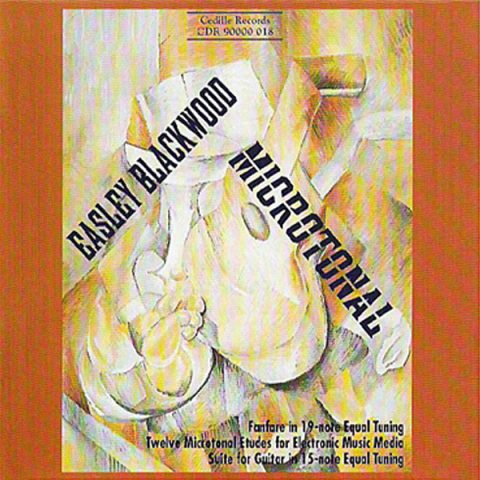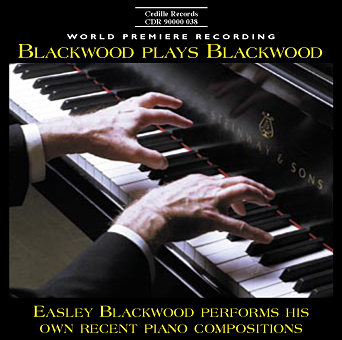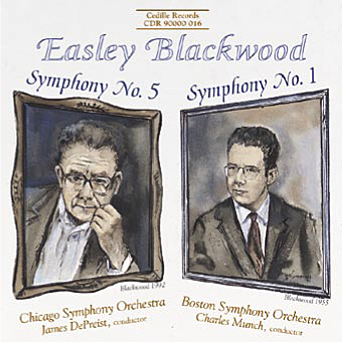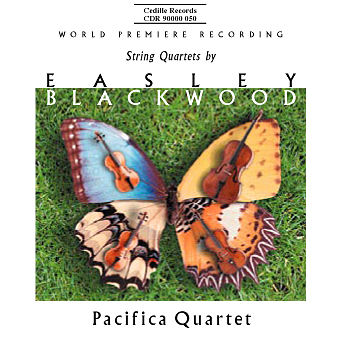Store
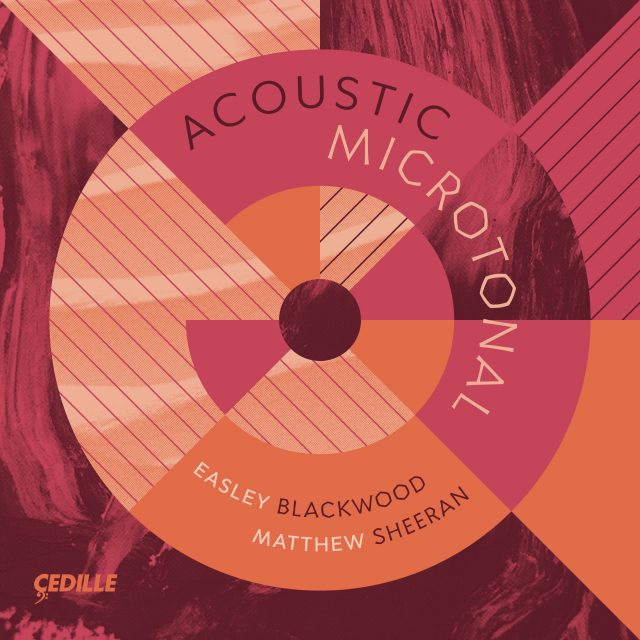
Honoring the one-year anniversary of Chicago-based microtonal composer Easley Blackwood, Jr.’s death, Cedille Records releases Acoustic Microtonal, a new and unconventional acoustic presentation of Blackwood’s Twelve Microtonal Etudes for Electronic Music Media, Op 28, arranged by Grammy-nominated composer and orchestrator Matthew Sheeran.
A student of Boulanger, Hindemith, and Messiaen, and a music professor at the University of Chicago, Blackwood (April 21, 1933–January 22, 2023) was an American composer, pianist, and music theorist regarded as a pioneering figure in the exploration and advancement of microtonal music.
His monumental work, Twelve Microtonal Etudes for Electronic Music Media, marked the culmination of Blackwood’s research into the techniques of dividing the octave into more than 12 equal parts. Blackwood wrote each of his 12 Etudes using tunings of 13 to 24 notes per octave, with each tuning resulting in its own musical form and style.
Blackwood recorded the Etudes on a polyfusion synthesizer in 1980. He noted in the preface to his score, “execution by conventional acoustic instruments is not advised,” but in the years since there have been unprecedented advances in music technology.
To create the acoustic versions, Matthew Sheeran deciphered the original score — which comprises 180 unique pitches overall — and arranged 12-note versions of the Etudes by approximating the musical logic and sound of each. Musicians from the Budapest Scoring Orchestra performed the new parts on acoustic instruments, which Sheeran recorded and microtonally re-tuned using the latest music software (Celemony/Melodyne), bringing a new level of realism to the Etudes.
Sheeran (b. 1989) has a broad and in-depth knowledge of and a wide interest in music of all genres. He studied music at the Guildhall School of Music and Drama and the University of Sussex, and composition at King’s College London. His music has been performed at the Aldeburgh Festival, St Edmundsbury Cathedral, and Westminster Abbey.
Cedille has released 14 recordings featuring Blackwood’s works, including Easley Blackwood: Microtonal (1994), featuring a reissue of Blackwood’s original, 1980 synthesizer recording of the Twelve Microtonal Etudes, plus later Blackwood microtonal works including his 1987 Suite for Guitar in 15-note Equal Tuning, Op. 33.
Acoustic Microtonal was produced by Matthew Sheeran and mixed by Brian Bolger. It was recorded in Budapest 2021–2022 at Rottenbiller Studios, Tom-Tom Studio A, and Pannónia Sound Systems.
Preview Excerpts
Blackwood; Sheeran, arr.
Twelve Microtonal Etudes, Op. 28 arranged for acoustic instruments
Artists
1: Easley Blackwood, Matthew Sheeran, Brian Bolger, Budapest Scoring Orchestra
Program Notes
Download Album BookletProgram Notes
Notes by Matthew Sheeran
“At this point, I am persuaded that the tonal and harmonic resources of the twelve-note equal scale have, in fact, been discovered and exploited. I think that’s something that only came true in about 1965 or 1970. After that, it’s been some kind of a rehash of what’s been done before.”
— Easley Blackwood, interview with Bruce Duffie, 1993
“I find his work in alternative tunings among the deepest and most appealing I’ve yet encountered.”
— Wendy Carlos, www.wendycarlos.com/open.html, 1996
Microtones, to paraphrase Charles Ives, are the “notes between the cracks.” Western instruments are designed to play a 12-tone chromatic scale, but while there are ways of accessing some microtones, this can go against the grain of a player’s traditional training. Composers throughout history have wrestled with this problem and have come up with many ingenious solutions, whether by modifying existing instruments or inventing entirely new ones. For this recording, Easley Blackwood’s monumental Twelve Microtonal Etudes for Electronic Music Media has been rearranged for traditional instruments and microtonally retuned using the latest cutting-edge computer software. This has brought a level of realism, expressiveness and clarity to the music that was previously out of reach.
In a 2019 interview with Stephen Weigel, Easley Blackwood recalled that in his childhood he tried to mimic on the piano the sound of the train whistle that passed by his home every day. Having absolute pitch, he was able to locate the notes D, G and B, but the last note, not-quite-F, was too flat and couldn’t be imitated. This was the beginning of his lifelong fascination with microtonality, a subject he pursued despite the discouragement of his teachers.
Blackwood’s early music was in the typical modernist, atonal idiom of many of his mid-20th-century contemporaries. In an 1982 article for Keyboard magazine, he recollects hearing quarter-tones for the first time during a 1948 performance of Bartók’s Sixth String Quartet. His first proper foray into microtonality was in the opera Gulliver (1975), where he experimented with 15-, 16-, and 23-tone equal temperaments. This music was performed using the Motorola Scalatron, a retunable electronic organ that Blackwood would later use to compose his Twelve Microtonal Etudes.
In 1978 Blackwood received a grant from the National Endowment for the Humanities to investigate microtonal tuning systems that equally divide the octave into anywhere from 13 to 24 notes. This research culminated in his groundbreaking Twelve Microtonal Etudes for Electronic Music Media (1980).
For the uninitiated, we usually divide the octave into 12 equally spaced parts. The combination of any two of these notes is called an interval, each one of which has its own unique sound quality, ranging from dissonant to consonant. These intervals are the building blocks of melody. Scales and modes can be constructed using combinations of whole steps and half steps, which in turn can be transposed into different keys; this is very much like changing time zones on a clock. Simultaneous combinations of more than two notes are known as chords and can be combined to form progressions. The nonstandard divisions of the octave in the Twelve Microtonal Etudes each have their own alternate music theory and contain musical shapes and pathways not available in the 12-tone system. Unique intervals, chords, modulations, and scales are found in each one of the etudes — some stranger than others. That being said, some of the pitches in the microtonal tuning systems coincide exactly with those in the traditional western chromatic scale, depending on whether the overall number of notes share common factors with 12. Blackwood was thus able to employ diminished seventh chords in the 16-note etude, whole-tone scales in the 18-note etude, and augmented triads in the 15-note etude.
Electronic instruments are ideally suited for playing and recording microtonal music. Blackwood himself performed the first and, until now, only commercial recording of the Twelve Microtonal Etudes for Electronic Music Media using the Polyfusion Synthesizer (Easley Blackwood: Microtonal, Cedille Records, 1994). In his 1980 preface to the score, he cautions against attempting to play the Etudes on acoustic instruments. In the years since Blackwood wrote those words, there have been unprecedented advances in music technology. Using Celemony’s Melodyne software, it is now possible to quantize individually recorded pitches to any microtonal scale. This meant that if the Etudes were translated into a playable 12-tone version, they could be recorded using acoustic instruments and then detuned afterwards to notes that would have otherwise been impossible to play. This would turn out to be a huge undertaking; when broken out, there are more than 27,000 notes in the Etudes, with 176 individual parts totaling over five hours’ worth of music. Melodyne works most effectively with monophonic material, therefore every part would need to be recorded in isolation and then retuned note by note.
Blackwood’s score is written using the standard five-line staff, and it introduces various new accidentals in addition to the usual sharp, flat and natural signs. There are 180 unique pitches per octave overall in the etudes, with two possible enharmonically equivalent accidentals for many of them. Deciphering this notation and then reducing everything to twelve notes was not a simple task. The playable version needed to approximate the musical logic of the original; merely rounding a pitch to the nearest 12-tone note wouldn’t work. Each etude had to be approached differently, some having more satisfactory solutions than others. A singular feature of some of these translations was that unlike in Blackwood’s original versions, they would finish in a different key than the one they started in.
Having adapted the Twelve Microtonal Etudes into a performable version, the next thing to do was to choose the instrumentation. Blackwood’s original score suggests various timbres: some specific (cornet, tinkly bells, oboe d’amore, ukulele), some fantastical (magic horn, ethereal pipes, enormous flute, exotic voices), others descriptive (hazy, glowing, radiant, veiled). He intended these only as starting points; many different orchestrations are possible and valid. The arrangements on this recording use standard orchestral forces; 11 musicians perform on 17 different instruments, each playing multiple overdubs. Instrumental ranges influenced the choice of key and on rare occasions were extended artificially. The sessions were recorded remotely over the course of a year with musicians from the Budapest Scoring Orchestra.
Blackwood wrote each etude in the musical style he felt was most idiomatic for the respective tuning system. The order of the Etudes and brief descriptions follow:
- I. 16 notes: Andantino
A mysterious alto flute melody accompanied by strings and harp.
- II. 18 notes: Allegro volando
Orchestrated for wind ensemble and in an impressionistic style, this etude was partially modelled on the “Dance of the Firebird” from Stravinsky’s ballet.
- III. 21 notes: Suite in four movements
A canonic Baroque Suite, with echoes of Bach’s Sonata for Violin and Harpsichord in E Major, BWV 1016.
- IV. 23 notes: Allegro moderato
Influenced by Gamelan music, the pitch material Blackwood uses in this etude closely approximates the Pelog and Slendro scales. There are several distinctive layers: glistening harp runs, melodious strings, horn signals, bitonal pizzicato, and interlocking wind figurations.
- V. 13 notes: Sostenuto
An angst-ridden duet for alto flute and flugelhorn, accompanied by dense strings and dissonant harp flourishes.
- VI. 15 notes: Lento
A sombre trumpet processional. The accompanying harp and string parts were inspired by the opening of Milhaud’s ballet, La création du monde.
- VII. 17 notes: Con moto
A lively juxtaposition of strings and winds, with a 3/8 meter giving it a pastoral character. The harmonic progressions were modelled on the music of Mussorgsky and Rimsky-Korsakov.
- VIII. 22 notes: Andante ma non troppo
A romantic string quintet, reminiscent of Schubert.
- IX. 24 notes: Moderato
A hyper-chromatic passacaglia, transposed up an octave in this arrangement.
- X. 14 notes: Allegramente
Highly syncopated and pandiatonic, duets of different wind instruments are accompanied by a homophonic group of brass and strings. This etude was inspired by Poulenc’s Sextet for piano and winds.
- XI. 20 notes: Comodo
A tragicomical song for bassoon, accompanied by strings and près de la table harp. Elements of the chord progression were borrowed from Henri Duparc’s song, “La Vie Antérieure.”
- XII. 19 notes: Allegro moderato
Written in sonata form and orchestrated for string ensemble, the musical material evokes Beethoven’s Waldstein and Les Adieux sonatas, as well as the Eroica Symphony.
A fascinating description of the music theory behind each etude can be found in Blackwood’s original liner notes for the album Microtonal (Cedille Records, 1994).
Recording these arrangements presented unique logistical challenges. For example, there are 36 staves of highly chromatic and virtuosic music in the 18-note etude; every part had to be acoustically separated. The most practical way to achieve this was to put each musician in their own isolation booth, where they could hear each other and the click track through headphones. There was also a monitor showing the current bar number. Although the musicians could see each other through glass windows, this was an extremely challenging and unnatural way to record. Taking place during the coronavirus pandemic, it was very much in the spirit of self-isolation!
After the recordings were completed, there was a huge amount of editing that needed to be done. The ear needed to be tricked into perceiving that this had been recorded as a real ensemble, as opposed to multiple isolated solos. The monophonic stems were then lined up against a microtonal guide track and manually retuned using Celemony’s Melodyne software.
So what does it sound like? In his 2021 dissertation, “Hearing the Tonality in Microtonality,” Michael Bruschi writes:
“Blackwood’s music provokes intensely visceral reactions across the board—whether of fascination, dumbfoundedness, or frustration—and there does not seem to be any middle ground […] Many have communicated to me the paradoxical sense that it sounds unlike anything they have ever encountered in their lives, yet at the same time, oddly similar to music they have heard before.”
This music is truly original and masterfully constructed, with gorgeous melodies, stunning chord progressions, and some incredibly exciting and moving passages. It is hoped that these recordings will inspire other composers to write microtonal music, especially using acoustic instruments. (There are ways to do this that do not involve electronic re-tuning. Blackwood’s Suite for Guitar in 15-note Equal Tuning, Op. 33, heard on the Cedille Records album Easley Blackwood: Microtonal, offers one example.) The microtonal universe is vast and yet the surface has only just been scratched…
Special thanks to William Ayers, Michael Bruschi, Aaron Andrew Hunt, Stephen Malinowski and Stephen Weigel.
Album Details
Producer Matthew Sheeran
Mixing Brian Bolger
Session Producer Bálint Sapszon
Engineers Péter Barabas, Dénes Rédly, Tamás Kurina, Bence Bobák, and Viktor Szabó
Recorded
Budapest 2021–2022 at Rottenbiller Studios, Tom-Tom Studio A, and Pannónia Sound Systems
Graphic Design Bark Design
CDR 3019
